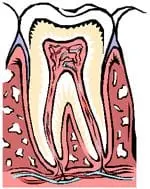Endodontic Retreatment Explained
When a root canal treatment fails, the first course of action that is usually taken is trying to re-do the root canal treatment. It is usually done by an endodontist (root canal specialist) or an experienced general dentist.

The process is very similar to root canal treatment; the difference is that besides taking any remaining infected tissue out, the doctor has to take old filling material, any posts and crowns, or any other obstacle in the pulp space out to be able to successfully disinfect and seal the area of the root canal.
After the root canal treatment is done your restorative dentist will place a crown to protect the tooth against fractures.
Endodontic Retreatment
With proper care, even teeth that have had root canal treatment can last a lifetime. But sometimes, a tooth that has been treated doesn't heal properly and can become painful or diseased months or even years after treatment. If your tooth failed to heal or develops new problems, you have a second chance. An additional procedure may be able to support healing and save your tooth. If you are experiencing dental pain or discomfort in a previously treated tooth, talk to an endodontist about retreatment.
As occasionally happens with any dental or medical procedure, a tooth may not heal as expected after initial treatment for a variety of reasons:
- Narrow or curved canals were not treated during the initial procedure.
- Complicated canal anatomy went undetected in the first procedure.
- The placement of the crown or other restoration was delayed following the endodontic treatment.
- The restoration did not prevent salivary contamination to the inside of the tooth.
In other cases, a new problem can jeopardize a tooth that was successfully treated. For example:
- New decay can expose the root canal filling material to bacteria, causing a new infection in the tooth.
- A loose, cracked or broken crown or filling can expose the tooth to new infection.
- A tooth sustains a fracture.
During retreatment, the endodontist will reopen your tooth and remove the filling materials that were placed in the root canals during the first procedure. The endodontist then carefully examines the tooth, looking for additional canals or new infection. The endodontist then removes any infection, cleans and shapes the canals, and places new filling materials. The opening is then sealed with a temporary filling. Once






